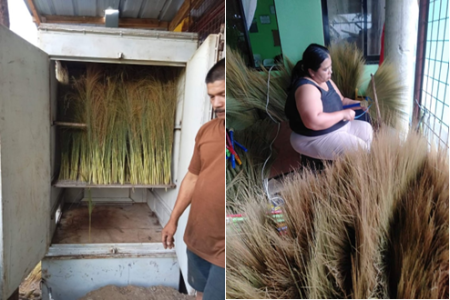TANNIN RESORCINOL FORMALDEHYDE AS POTENTIAL GLUE FOR THE MANUFACTURE OF PLYBAMBOO | 26/04/2024

ABSTRACT
The tannin extracted from mangium ( Wild) tree bark exhibits strong affinity toward formaldehyde when both being reacted forming the tannin formaldehyde polymer which further could serve as resin adhesive. To improve the bonding strength and enhance the curing process, the tannin and formaldehyde is co-polymerized with resorcinol to form tannin resorcinol formaldehyde (TRF) resin. This resin is expectedly useful in the gluing work for the manufacture of reconstituted wood or other ligno-cellulosic products such as plywood, glue laminated timber, and laminated veneer lumber. In relevant, the tannin extract (T) was prepared from mangium bark, then allowed to copolymerize through the reaction with resorcinol (R) and formaldehyde (F) to produce the TRF resin. In such copolymerization, the mole ratios of T : R : F was such that the mole portion of R varied at consecutively: 0.2, 0.5, 0.7, 0.9 and 1.1, while the mole portion of T and F was constant at the ratio of 1 : 1. The course and phenomena that might occur during the TRF polymerization was scrutinized using XRay diffraction (XRD) and Differential Thermal Analysis (DTA) to determine the optimum ratio of T : R : F in formulating the TRF adhesive. The resulting formulated TRF was later to be used in the gluing of ply-bamboo assembly consisting of 7 plies, which were virtually the veneers prepared from tali bamboo ( ) species. The already shaped seven-ply-bamboo further sustained the hotpressing at 20 kg/cm employing 130 C for 20 minutes. Afterwards, the resulting 7-ply-bamboo panel was examined of its physical and mechanical (strength) properties, glue-bond quality and formaldehyde emission. Result revealed that the TRF resin with mole ratio of T : R : F at 1 : 0.5 : 1 exhibited the highest crystallinity (51.33 %) and melting glass transition at 277.14 C. In addition, the TRF adhesive at such mole ratio exhibited the thermogram and diffractogram characterization which were similar to those of the conventional PRF (phenol-resorcinol-formaldehyde) adhesive. Consequently, the TRF with such ratio was judged as the optimum formulation to be used as adhesive for the gluing of ply-bamboo assembly. The resulting ply-bamboo exhibited particular characteristics, i.e density 0.904 g/cm MOR 1,214.62 kg/cm , MOE 19,493 kg/cm , bonding strength 38,40 kg/cm and zero percent (0%) delamination, and formaldehyde emission 0.043 mg/L. The properties of ply bamboo could mostly satisfy, except the MOE, the criteria of Indonesian and Japanese standard for structural that used the conventional non-renewable adhesive (PF and UF). As a result, the TRF adhesive as derived from the renewable stuff (tannin from mangium bark), with remarkably low formaldehyde emission seems more consecutively prospective environmentally friendly, significantly potential to replace sooner or later the non-renewable and less environmentally friendly conventional adhesive (UF and PF), thereby indicatively taking part in greening the environment and mitigating the global warming.
Keywords: mangium bark, tannin extract, ply-bamboo, TRF-adhesive
















